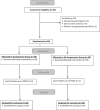The Feasibility of Blinding Intraoperative Electro-Auricular Acupuncture Under Neuraxial Anesthesia
- PMID: 34471447
- PMCID: PMC8403191
- DOI: 10.1089/acu.2021.0003
The Feasibility of Blinding Intraoperative Electro-Auricular Acupuncture Under Neuraxial Anesthesia
Abstract
Objective: Demand for complementary medicine, in particular, acupuncture, has increased over the past few years but widespread acceptance has been limited, in part, by the lack of high-quality studies, including lack of blinding. Acupuncture studies traditionally have difficulty with blinding as sham acupuncture can have up to a 40%-50% analgesic effect. This study randomized patients between Acupuncture and No Acupuncture (standard of care) without using sham needles. The primary outcome was adequate blinding of electro-auricular acupuncture in the intraoperative setting with secondary outcomes of pain/nausea control. Materials and Methods: Forty patients undergoing anterior cruciate ligament reconstruction were enrolled. Subjects were randomly assigned to receive acupuncture (Enhanced Electro-Auricular Trauma Protocol) or No Acupuncture during their surgeries. All patients received spinal anesthesia and intravenous midazolam, ketamine, and propofol for sedation. 1000 mg of intravenous (IV) acetaminophen and up to 30 mg of IV ketorolac were given at closure. No opioids or peripheral nerve blocks were administered intraoperatively. Results: Bang's Blinding indices were 0.2 (95% confidence interval [CI]: -0.02, 0.42) in the Acupuncture group, and 0.11 (95% CI: -0.10, 0.31) in the No Acupuncture group on postoperative day 1. Both groups had adequate blinding. There were no differences in pain scores, nausea/vomiting incidence, opioid consumption 0-24 hours, or patient satisfaction. Five patients in the No Acupuncture group received rescue blocks, while no patients in the Acupuncture group needed a rescue block (Fisher's exact test: p = 0.047). Conclusions: This study proved the primary hypothesis that adequate blinding of intraoperative acupuncture can be performed when patients are under sedation and neuraxial anesthesia. This research is registered at ClinicalTrials.gov as Clinical Trial Registration #: NCT03711734.
Keywords: auricular acupuncture; auriculotherapy; complementary and alternative medicine; electroacupuncture; pain management.
Copyright 2021, Mary Ann Liebert, Inc., publishers.
Conflict of interest statement
SIC, RMN, DD, HZ, LHT, MMM, AMK declare that they have no conflicts of interest. RGM serves as Deputy Editor for the Journal of Bone and Joint Surgery, Associate Editor for the Journal of Bone and Joint Surgery Evidence Based Orthopedics, has Equity compensation for seat on science advisory board for MEND Nutrition Inc., and receives royalties for books published by Springer and Demos Health. SMS consults for Smith and Nephew as well as Verice.
Figures


References
-
- Gan TJ, Jiao KR, Zenn M, Georgiade G. A randomized controlled comparison of electro-acupoint stimulation or ondansetron versus placebo for the prevention of postoperative nausea and vomiting. Anesth Analg. 2004;99(4):1070–1075 - PubMed
-
- Cai RL, Shen GM, Wang H, Guan YY. Brain functional connectivity network studies of acupuncture: A systematic review on resting-state fMRI. J Integr Med. 2018;16(1):26–33 - PubMed
Associated data
LinkOut - more resources
Full Text Sources
Medical
Miscellaneous
